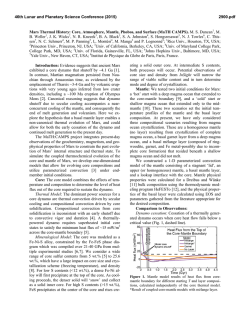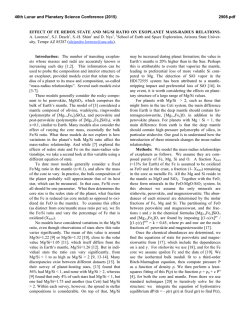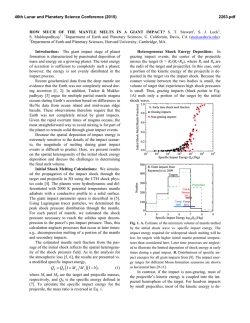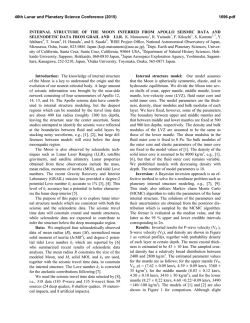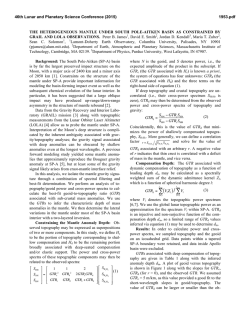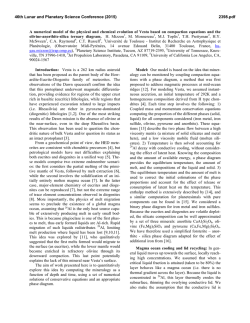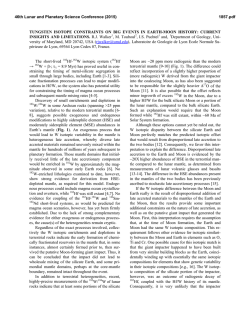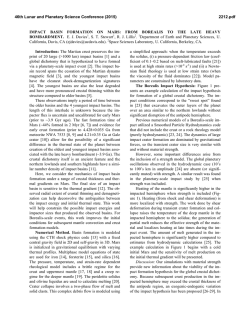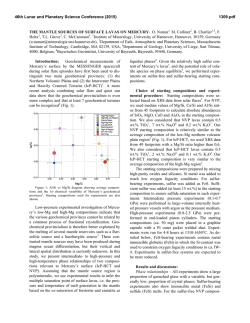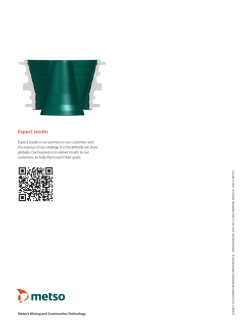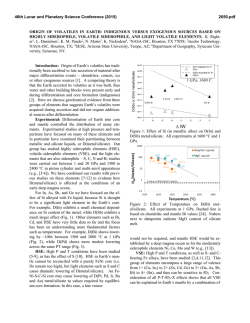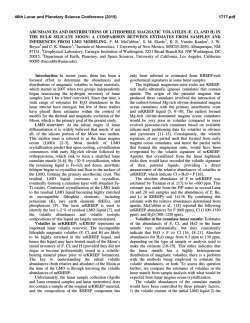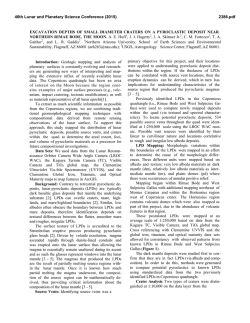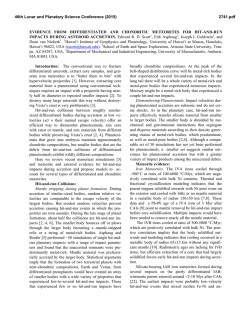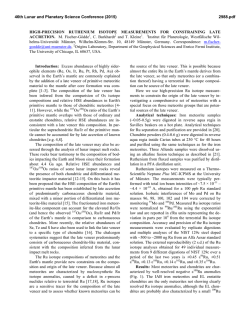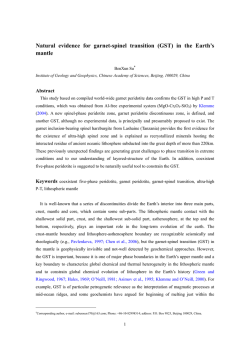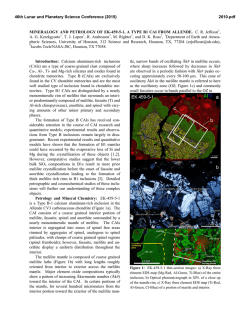
THERMAL EVOLUTION OF THE CORE AND MANTLE OF MARS
46th Lunar and Planetary Science Conference (2015) 2617.pdf THERMAL EVOLUTION OF THE CORE AND MANTLE OF MARS: EFFECTS OF A SEQUENCE OF BASIN-FORMING IMPACTS. J. H. Roberts1, and J. Arkani-Hamed2, 1Johns Hopkins University Applied Physics Laboratory, 11100 Johns Hopkins Rd., Laurel, MD 20723 ([email protected]), 2Dept. of Physics University of Toronto, 60 St. George St., Toronto, ON, Canada M5S 1A7 Introduction: 20-30 extant and buried giant impact basins of mid-Noachian age have been identified on Mars [1, 2]. The youngest of these basins [1, 3] are either weakly magnetized or completely demagnetized [4], indicating that a global magnetic field [5] was not present and that a core dynamo was not operating at the time those basins formed. Shock heating from this sequence of basin-forming impacts modified the pattern of mantle convection [6,7]. The heating produced by the seven largest impacts (Acidalia, Amazonis, Ares, Chryse, Daedalia, Hellas, and Utopia) penetrates below the core-mantle boundary (CMB) [8] (e.g., Figure 1). When the impact heating reaches the core, the temperature increase is strongest at the top of the core. Dynamo models incorporating impact heating [9,10] find that the low-viscosity core fluid rapidly erases lateral variations, resulting in a spherically-symmetric, stably stratified core temperature profile that increases outward. This symmetry has been previously exploited and a 1-D parameterization of core cooling [8] has been coupled to 2-D axisymmetric mantle convection models [11]. This allows the simultaneous modeling of the thermal evolution of both core and mantle, without full finite-element modeling in two regions with radically different material properties and timescales. These coupled models showed that a single basin-forming impact could halt dynamo activity for 100 My, and that the core did not become fully convective again for nearly 1 Gy after the impact. Here, we expand this investigation into 3D and consider the full sequence of basin-forming impacts large enough to affect the core. Because the time interval between impacts [1,3] is much shorter than the timescale for resumption of dynamo activity following an impact [2], subsequent impacts may delay this recovery. Our goal is to obtain a better estimate of the time scale for restoration of post-impact core dynamo activity. Because the disappearance of the magnetic field exposes the early atmosphere to solar wind activity, constraining the history of the dynamo is critical for understanding climate evolution and habitability of the surface. Impact heating: We compute the shock pressure due to formation of the seven largest impact basins in the core and mantle using ray-tracing. We determine the waste heat following passage of the shock using scaling laws [12,13]. Figure 1: Temperature increase (before taking melting into account) from the Utopia-forming impact at 10 km/s. Temperature profile is axisymmetric about the impact axis, shown here at the top of the figure; this does not correspond to the geographic pole. Core-Mantle Coupling: We model mantle convection using the finite element code CitcomS in 3D spherical geometry [14-15]. The initial temperature profile in both core and mantle is adiabatic, consistent 46th Lunar and Planetary Science Conference (2015) with convection in both regions, with conductive thermal boundary layers (TBL) at the surface and both sides of the CMB. At the time of each impact [1] we introduce a temperature perturbation resulting from shock heating into the core and mantle (Figure 1 shows the temperature increase from the Utopia impact). The axisymmetric temperature increase is rotated such that the impact axis coincides with the geographic location of the center of the impact basin. We restrict the mantle temperature to the solidus [7, 11], and assume that the impact melt does not participate in the mantle dynamics. Stratification of the core occurs very quickly compared to mantle dynamics [9-10], and we horizontally average the temperature in the core. The radiallyvarying temperature in the outer core following the Utopia impact is shown in Figure 2. At a given timestep, we fix the mantle temperature and solve the 1D enthalpy equation in the core and lower TBL of the mantle over a time corresponding to a mantle timestep. We then update the temperature at the CMB and TBL, and let the mantle convection progress for another timestep. We continue this iteration until the time of the next impact, and repeat the above steps until the last impact has occurred, the core temperature becomes almost adiabatic and the entire core is convecting. Mantle convection then proceeds while the cooling core retains an adiabatic temperature. Results and Discussion: The heating for the basinforming impacts, while substantial, is more modest than for the Borealis-sized impact considered in the 2D study [11]. Here, the mantle dynamics are altered and a significant amount of impact melt is produced in the near surface. However, only the outermost core is af- Figure 2: Temperature profile in the outer core after the Utopia impact and core stratification. 2617.pdf fected; the inner core temperature is still adiabatic. Immediately following the impact, the inner core may remain convective, although whether the heat flux is strong enough to sustain a dynamo is still under investigation. Because the conductivity of the core is higher than that of the mantle, the top of the core will cool by conduction into the deeper core faster than across the CMB, deepening the zone of stable stratification. As in previous studies [8,11], further core cooling should result in formation of a convecting zone at the top of the core that propagates downwards as the thermal gradient becomes adiabatic at greater depths. The evolution of the magnetic Reynolds number, the timescales at which dynamo activity is halted and resumed for, and at which the core again becomes fully convective following the sequence of impacts described above are under investigation. The core-mantle coupling procedure presented here provides a self-consistent model of heat transfer between the core and mantle without requiring full finite element modeling in the core. References: [1] Frey H. V. et al. (2008) GRL, 35, L13203. [2] Mannoia L. M. and Frey H. V. (2014) LPSC, 45, 1892. [3] Robbins et al., 2013, Icarus, 225., 173-184. [4] Lillis R. J. et al. (2008) GRL, 35, L14203. [5] Acuña et al., 1999, Science, 284. 790 [6] Roberts J. H. et al. (2009), JGR, 114, E04009. [7] Roberts J. H. and Arkani-Hamed J. (2012), Icarus, 218, 278-289. [8] Arkani-Hamed J. (2012) PEPI, 196-197, 83-96. [9] Arkani-Hamed J. and Olson P. (2010) GRL, 37, L02201. [10] Arkani-Hamed J. and Olson P. (2010) JGR, 115, E07012. [11] Roberts and Arkani-Hamed (2014) JGR, 119, 729-744. [12] Pierazzo E. et al. (1997) Icarus, 127, 208-223. [13] Watters W. et al. (2009) JGR, 114, E02001. [14] Zhong S. et al. (2000) JGR, 105, 11,063-11,082. [15] Tan, E. et al. (2014), GGG, 7, Q06001.
© Copyright 2026
